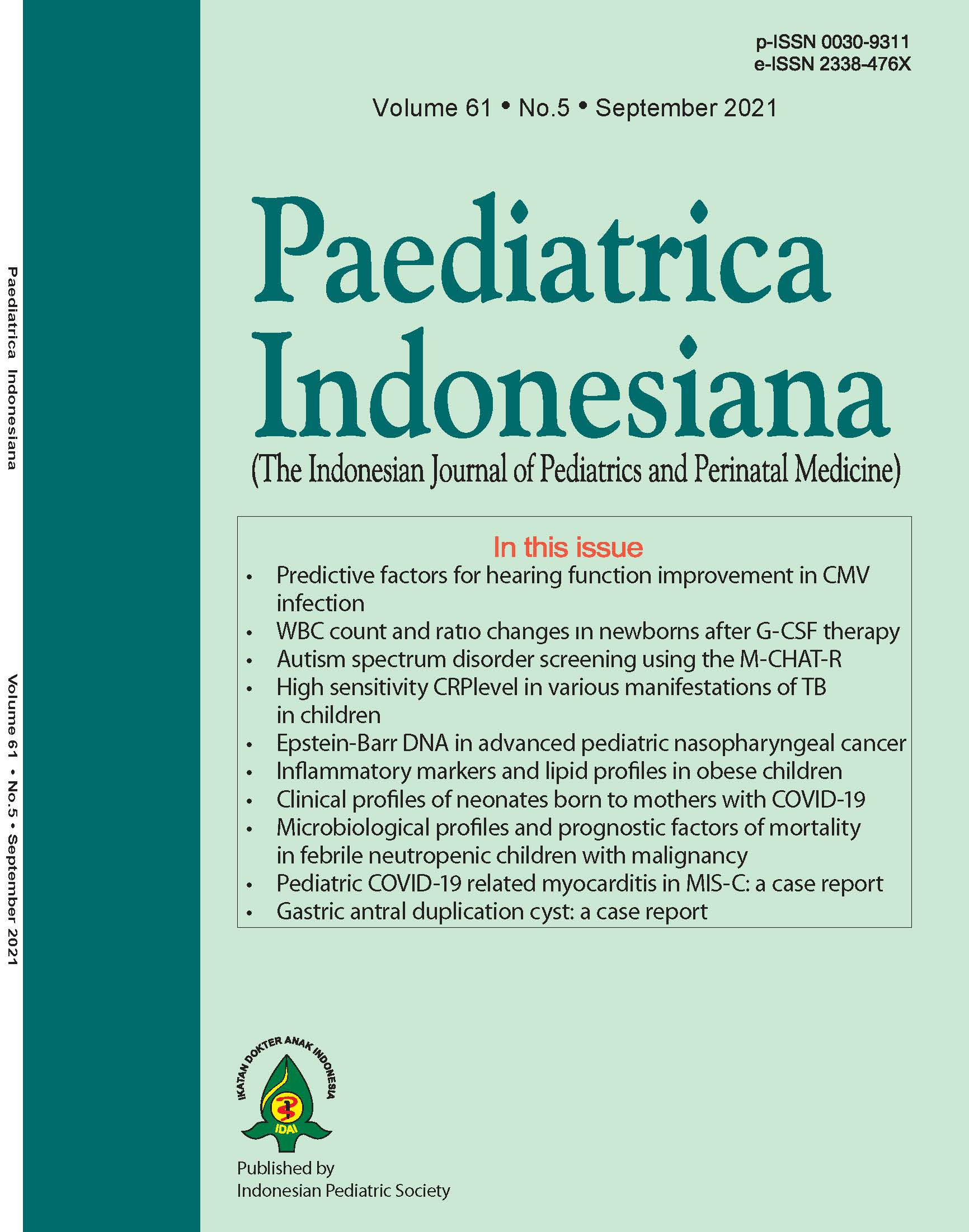Inflammatory markers and lipid profiles in obese children
DOI:
https://doi.org/10.14238/pi61.5.2021.271-6Keywords:
Inflammatory marker, lipid abnormality, obese, childrenAbstract
Background Over 340 million children and adolescents aged 5-19 were overweight or obese in the year 2016. Individuals with obesity are at risk for metabolic disorders and lipid abnormalities. Adipose tissue is a major source of pro-inflammatory cytokines.
Objective To evaluate possible correlations between inflammatory markers IL-6, TNFa, and hs-CRP with lipid profiles between obese and non obese children.
Methods Eighty children, aged 13 to 15 years, were enrolled in this study (40 normoweight and 40 obese). All participants’s ( obese and normoweight children) total plasma cholesterol, HDL cholesterol, triglycerides, as well as circulating levels of inflammatory factors, such as TNF-α, IL-6, and high sensitivity-C-reactive protein (hs-CRP) level were measured.
Results Obese children had significantly higher triglycerides (TG) and cholesterol, as well as lower HDL than normoweight subjects. Mean LDL levels were not significantly different between groups. The IL-6, TNFa, hs-CRP levels were significantly positively correlated with waist circumference. Analysis of the 4 blood lipid parameters and 3 inflammatory markers revealed significant positive correlations of triglycerides to TNFa and hs-CRP. In addition, HDL had significant negative correlations to both TNFa and hs-CRP. No correlations were found between IL-6 and the 4 lipid parameters, nor between TNFa or hs-CRP to LDL and cholesterol. Multivariate regression analysis revealed a significant association between weight-height ratio with hs-CRP (R2 0.118; 95%CI 1.65 to 191; P=0.046). Obesity is associated with adverse lipid and inflammations markers in children.
Conclusion Obesity was associated with higher TG, cholesterol, TNF, and hs-CRP levels, as well as lower HDL.
References
2 World Health Organisation. Waist circumference and waist–hip ratio. Report of a WHO Expert Consultation. [cited YEAR MONTH DATE]. Available from: https://www.who.int/publications/i/item/9789241501491.
3 Rachmi CN, Agho KE, Li M, Baur LA. Stunting, underweight and overweight in children aged 2.0–4.9 years in Indonesia: prevalence trends and associated risk factors. PLoS One. 2016;11:e0154756. DOI: 10.1371/journal.pone.0154756.
4 Rodríguez-Hernández H, Simental-Mendía LE, Rodríguez-Ramírez G, Reyes-Romero MA. Obesity and inflammation: epidemiology, risk factors, and markers of inflammation. Int J Endocrinol. 2013;2013:678159. DOI: 10.1155/2013/678159.
5 Chang CJ, Jian DY, Lin MW, Zhao JZ, Ho LT, Juan CC. Evidence in obese children: contribution of hyperlipidemia, obesity-inflammation, and insulin sensitivity. PLoS One. 2015;10:e0125935. DOI:10.1371/journal.pone.0125935.
6 Division of Nutrition, Physical Activity, and Obesity. Overweight & Obesity- Defining Childhood Overweight & Obesity. Available from : www. Cdc.gov
7 Zoair AM, Muhammad KT, Abu-Ammo DE, Motawea MM. Lipid profile and some cardiac functions in children with obesity. Egypt Pediatr Assoc Gaz. 2013;61:15-22. DOI: 10.1016/j.epag.2013.04.005.
8 Arjona-Villicaña RD, Herrera-Sánchez LF, Sumárraga-Ugalde C del M, Alcocer-Gamboa MA. Relationship between body mass index and lipid profile in obese Mexican children and adolescents: a retrospective analysis. Boletín Médico del Hosp Infant México (English Ed). 2014;71:88-94.
9 Giordano U, Ciampalini P, Turchetta A, Santilli IA, Calzolari F, Crino A, et al. Cardiovascular hemodynamics: relationships with insulin resistance in obese children. Pediatr Cardiol. 2003;24:548-52. DOI: 10.1007/s00246-003-0368-8.
10 Elnashar NA, Elhosary AA, Elnashar MA, Mohamed HA. Some inflammatory and endothelial dysfunction biomarker levels in obese pre-pubertal children. IOSR J Biotechnol Biochem. 2017;03:71-7. DOI: 10.9790/264x-03027177.
11 Ebrahimi, M, Heidari?Bakavoli, AR, Shoeibi S, Mirhafez SR, Moohebati M, Esmaily H, et al. Association of serum hs?CRP levels with the presence of obesity, diabetes mellitus, and other cardiovascular risk factors. J Clin Lab Anal. 2016;30:672-6. DOI: 10.1002/jcla.21920.
12 Tateya S, Kim F, Tamori Y. Recent advances in obesity-induced inflammation and insulin resistance. Front Endocrinol (Lausanne). 2013;4:93. DOI: 10.3389/fendo.2013.00093.
13 Yousuf Omair, Mohanty B, Martin S, Joshi P, Blaha M, Nasir K, et al. High-Sensitivity C reactive protein and cardiovascular disease : a resolute belief or an elusive link?. J Am Coll Cardiol. 2013 Jul 30; 62(5) : 397-408. DOI: 10.1016/j.jacc.2013.05.016.
14 Choi J, Joseph L, Pilote L. Obesity and C-reactive protein in various populations: a systematic review and meta-analysis. Obes Rev. 2013;14:232-44. DOI: 10.1111/obr.12003.
15 Brooks GC, Blaha MJ, Blumenthal RS. Relation of C-reactive protein to abdominal adiposity. Am J Cardiol. 2010;106:56-61. DOI: 10.1016/j.amjcard.2010.02.017.
16 Faucher G, Guénard F, Bouchard L, Garneau V, Turcot V, Houde A, et al. Genetic contribution to C-reactive protein levels in severe obesity. Mol Genet Metab. 2012;105:494-501. DOI: 10.1016/j.ymgme.2011.11.198.
17 El-Byoumy I. Interleukin 6 as inflammatory marker and insulin resistance in obese Kuwaiti adolescents. Integr Obes Diabetes. 2017;3:1-3. DOI: 10.15761/iod.1000181.
18 Fried SK, Bunkin DA, Greenberg AS. Omental and subcutaneous adipose tissues of obese subjects release interleukin-6: depot difference and regulation by glucocorticoid. J Clin Endocrinol Metab. 1998;83:847-50. DOI: 10.1210/jcem.83.3.4660.
19 Mohamed-Ali V, Goodrick S, Rawesh A, Katz DR, Miles JM, Yudkin JS, et al. Subcutaneous adipose tissue releases interleukin-6, but not tumor necrosis factor-alpha, in vivo. J Clin Endocrinol Metab. 1997;82:4196-200. DOI: 10.1210/jcem.82.12.4450.
20 da Silva JP, Ataide-Lima RP, de Carvalho Pereira D, de Oliviera Silva CS, Rodriguez Goncalves C, Filho MB, et al. Association between waist-to-height ratio, isolated and combined morbidities and C-reactive protein in the elderly: a clinical–epidemiology study. Int J Environ Res Public Health. 2014;11:9595-606. DOI: 10.3390/ijerph110909595.
21 Selvin E, Paynter NP, Erlinger TP. The effect of weight loss on C-reactive protein: a systematic review. Arch Intern Med. 2007;167:31-39. DOI: 10.1001/archinte.167.1.31.
22 Forsythe LK, Wallace JM, Livingstone MB. Obesity and inflammation: the effects of weight loss. Nutr Res Rev. 2008;21:117-133. DOI: 10.1017/S0954422408138732.
Downloads
Published
How to Cite
Issue
Section
License
Authors who publish with this journal agree to the following terms:
Authors retain copyright and grant the journal right of first publication with the work simultaneously licensed under a Creative Commons Attribution License that allows others to share the work with an acknowledgement of the work's authorship and initial publication in this journal.
Authors are able to enter into separate, additional contractual arrangements for the non-exclusive distribution of the journal's published version of the work (e.g., post it to an institutional repository or publish it in a book), with an acknowledgement of its initial publication in this journal.
Accepted 2021-09-20
Published 2021-09-20














